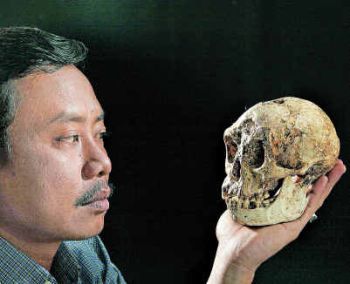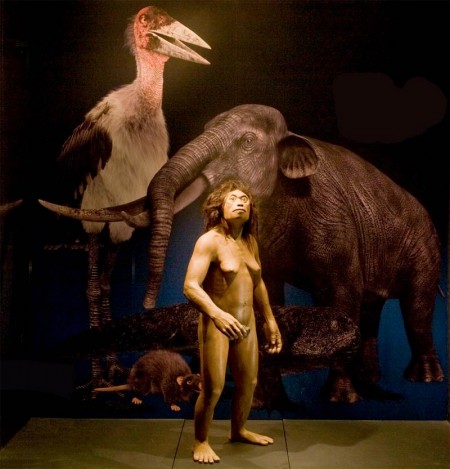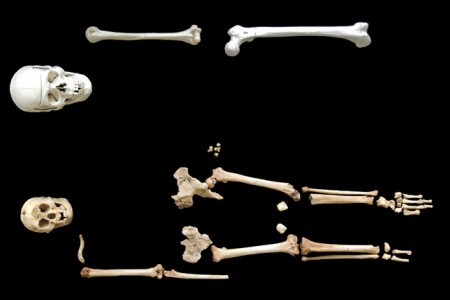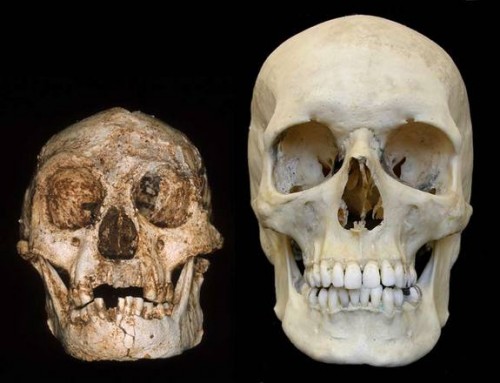As the recent supposed sighting of a small group of Orang Pendek in Sumatra is debated a recent Article on LiveScience addresses new research in the question of whether or not Homo Florensiensis were a distinct species or simply modern humans of small stature, as the article points out is not uncommon on isolated islands with small breeding populations.
The Real ‘Hobbit’ Had Larger Brain Than Thought
Charles Choi, LiveScience Contributor
Date: 16 April 2013The brain of the extinct “hobbit” was bigger than often thought, researchers say.
These findings add to evidence that the hobbit was a unique species of humans after all, not a deformed modern human, scientists added.
The 18,000-year-old fossils of the extinct type of human officially known as Homo floresiensis were first discovered on the remote Indonesian island of Flores in 2003. Its squat, 3-foot-tall (1 meter) build led to the hobbit nickname.
Scientists had suggested the hobbit was a unique branch of the human lineage Homo. It may have descended from Homo erectus, the earliest undisputed ancestor of modern humans, or an even more primitive extinct species of human, Homo habilis, which had a more apelike skeleton. However, other researchers have argued it was unlikely another species of human lasted so close to the present day, and that the hobbit was really a modern human with microcephaly, a condition that leads to an abnormally small head, a small body and some mental retardation.
Big brains?
One method that may help solve the mystery of the hobbit’s status involves comparing the size of its brain with the size of its body. Scientists could then make similar comparisons with modern and extinct human groups and note the hobbit’s differences from the groups. However, the actual size of the hobbit’s brain was unclear — past estimates for its size ranged from 380 to 430 cubic centimeters (23 to 26 cubic inches), inviting confusing answers when it came to analyzing the hobbit.
To help resolve this question, researchers scanned the interior of the only known hobbit skull with a high-resolution CT scan for the first time. They found the hobbit’s brain was larger than previously suggested — 426 cubic cm (nearly 26 cubic inches), instead of the commonly cited figure of 400 cubic cm. (The modern human brain is 1,300 cubic centimeters, or 79 cubic inches, large on average.)
Armed with this knowledge, the scientists then compared the hobbit with other groups of humans. Past studies had argued the hobbit could not have evolved from Homo erectus, which typically had a brain about 1,000 cubic centimeters (61 cubic inches) in size, because it would have suggested Homo erectus shrunk an unreasonable degree over time. However, it turned out Javanese specimens of Homo erectus had brains about 860 cubic cm (52 cubic inches) large, and combined with the newfound increased size of the hobbit’s brain, the researchers say it now seems possible that Homo erectus may be the ancestor of Homo floresiensis.
“This study does not prove who was the actual ancestral species for Homo floresiensis, but it has removed the most important concern for the model, which supposes Homo erectus was the ancestral species,” researcher Yousuke Kaifu, a paleoanthropologist at Japan’s National Museum of Nature and Science in Tokyo, told LiveScience.
Small StatureCredit: Stony Brook UniversityScientists unearthed the 18,000-year-old remains of a 3-foot-tall adult female hominid in 2003 on the remote Indonesian island of Flores. Since then scientists have argued whether the remains belonged to a human with an abnormally small head or represented a new species in the human family tree. The diminutive female had a brain approximately one-third the size of modern adult humans
Hobbit SkullCredit: Professor Peter Brown, University of New EnglandTo look into microencephaly, a team of scientists led by Dean Falk, a paleoneurologist at Florida State University, compared computer-generated three-dimensional reconstructions, called “endocasts,” of brains from nine microcephalic modern humans with those of 10 normal modern-human brains. They found two ratios created using different skull measurements could accurately distinguish the normal humans (skull, right) from the microcephalics. When Falk’s team applied this classification system to a virtual endocast the Hobbit’s skull (left), they found its features more closely resembled that of a normal human than a microcephalic.
Revealing a FaceCredit: University of WollongongIn more recent research, anthropologist Susan Hayes, a senior research fellow at University of Wollongong, New South Wales, fleshed out the face of the female Hobbit. To do so, Hayes uploaded information from 3D imaging scans of the skull into a computer graphic program and also looked at portraits by paleo-artists of the Hobbit, finding these earlier interpretations were skewed toward monkey features; her examination, meanwhile, suggested modern features were more accurate.
If Homo Florensiensis is Orang Pendek, or not, if Orang Pendek is more than tribal mythology or not there is still value in being able to look into the eyes of one of our predecessors. It can be easy to forget that while we Homo Sapiens, Cro Magnons or call us what you will may have clawed our way to the highest rung of the evolutionary ladder on this planet, we were not the only ones making the climb and but for a quirk of climate or geography or disease it could easily have not been us.
And don’t forget to visit Lindsay, say Hi and Like us on our FaceBook Page where you will find more commentary and content.
2 comments








